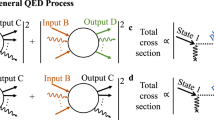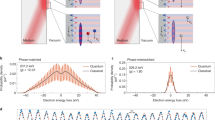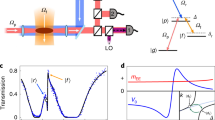Abstract
Although electrons and photons are the most widely researched elementary particles, their interactions outside of the confines of a material are not yet fully explored. Here, we report the use of nonlinear-optical two-photon transitions for the quantum-coherent control of a free-electron matter wave in free space. We superimpose an electron beam with two crossed laser beams of different photon energies for non-linear Compton scattering. At suitable angle combinations, the electron energy spectrum becomes modulated into discrete energy sidebands with thousands of interference maxima. We explain our observations by the cascaded addition and subtraction of two-photon pairs under three-body conservation of energy and momentum. Calculations reveal that the electron matter wave converts into pulses of few-attosecond duration. These results show the general importance of matter wave coherences in scattering phenomena and provide a way for investigating and creating quantum correlations and entanglement between massive and massless elementary particles without the need for a classical coupling construct.
This is a preview of subscription content, access via your institution
Access options
Access Nature and 54 other Nature Portfolio journals
Get Nature+, our best-value online-access subscription
$29.99 / 30 days
cancel any time
Subscribe to this journal
Receive 12 print issues and online access
$209.00 per year
only $17.42 per issue
Buy this article
- Purchase on Springer Link
- Instant access to full article PDF
Prices may be subject to local taxes which are calculated during checkout




Similar content being viewed by others
Data availability
Source data are provided with this paper. All other data that support the plots within this paper and other findings of this study are available from the corresponding author upon reasonable request.
References
Reinhardt, O., Mechel, C., Lynch, M. & Kaminer, I. Free-electron qubits. Ann. Phys. 533, 2000254 (2021).
Tsarev, M. V., Ryabov, A. & Baum, P. Free-electron qubits and maximum-contrast attosecond pulses via temporal Talbot revivals. Phys. Rev. Res. 3, 043033 (2021).
Kealhofer, C. et al. All-optical control and metrology of electron pulses. Science 352, 429–433 (2016).
Zhang, D. F. et al. Segmented terahertz electron accelerator and manipulator (STEAM). Nat. Photonics 12, 336 (2018).
Tauchert, S. R. et al. Polarized phonons carry angular momentum in ultrafast demagnetization. Nature 602, 73–77 (2022).
García de Abajo, F. J. G. & Di Giulio, V. Optical excitations with electron beams: challenges and opportunities. ACS Photonics 8, 945–974 (2021).
Hayun, A. B. et al. Shaping quantum photonic states using free electrons. Sci. Adv. 7, eabe4270 (2021).
Kfir, O., Di Giulio, V., García de Abajo, F. J. G. & Ropers, C. Optical coherence transfer mediated by free electrons. Sci. Adv. 7, eabf6380 (2021).
Karnieli, A., Rivera, N., Arie, A. & Kaminer, I. The coherence of light is fundamentally tied to the quantum coherence of the emitting particle. Sci. Adv. 7, eabf8096 (2021).
Dahan, R. et al. Imprinting the quantum statistics of photons on free electrons. Science 373, eabj7128 (2021).
Priebe, K. E. et al. Attosecond electron pulse trains and quantum state reconstruction in ultrafast transmission electron microscopy. Nat. Photonics 11, 793–797 (2017).
Morimoto, Y. & Baum, P. Diffraction and microscopy with attosecond electron pulse trains. Nat. Phys. 14, 252–256 (2018).
Dahan, R. et al. Resonant phase-matching between a light wave and a free-electron wavefunction. Nat. Phys. 16, 1123–1131 (2020).
Baum, P. & Krausz, F. Capturing atomic-scale carrier dynamics with electrons. Chem. Phys. Lett. 683, 57–61 (2017).
Di Giulio, V. & García de Abajo, F. J. G. Electron diffraction by vacuum fluctuations. New J. Phys. 22, 103057 (2020).
Beierle, P. J., Zhang, L. Y. & Batelaan, H. Experimental test of decoherence theory using electron matter waves. New J. Phys. 20, 113030 (2018).
Sonnentag, P. & Hasselbach, F. Measurement of decoherence of electron waves and visualization of the quantum–classical transition. Phys. Rev. Lett. 98, 200402 (2007).
Schattschneider, P. & Loffler, S. Entanglement and decoherence in electron microscopy. Ultramicroscopy 190, 39–44 (2018).
Haroutunian, V. M. & Avetissian, H. K. Analog of Kapitza–Dirac effect. Phys. Lett. A 51, 320–322 (1975).
Smirnova, O., Freimund, D. L., Batelaan, H. & Ivanov, M. Kapitza-Dirac diffraction without standing waves: diffraction without a grating? Phys. Rev. Lett. 92, 223601 (2004).
Di Giulio, V. & García de Abajo, F. J. Optical-cavity mode squeezing by free electrons. Nanophotonics 11, 4659–4670 (2022).
Aidelsburger, M., Kirchner, F. O., Krausz, F. & Baum, P. Single-electron pulses for ultrafast diffraction. Proc. Natl Acad. Sci. USA 107, 19714–19719 (2010).
Miller, R. J. D. Femtosecond crystallography with ultrabright electrons and x-rays: capturing chemistry in action. Science 343, 1108–1116 (2014).
Tsarev, M., Ryabov, A. & Baum, P. Measurement of temporal coherence of free electrons by time-domain electron interferometry. Phys. Rev. Lett. 127, 165501 (2021).
Kozák, M., Eckstein, T., Schönenberger, N. & Hommelhoff, P. Inelastic ponderomotive scattering of electrons at a high-intensity optical travelling wave in vacuum. Nat. Phys. 14, 121–125 (2018).
Kozák, M., Schönenberger, N. & Hommelhoff, P. Ponderomotive generation and detection of attosecond free-electron pulse trains. Phys. Rev. Lett. 120, 103203 (2018).
Kapitza, P. L. & Dirac, P. A. M. The reflection of electrons from standing light waves. Proc. Camb. Philos. Soc. 29, 297–300 (1933).
Freimund, D. L., Aflatooni, K. & Batelaan, H. Observation of the Kapitza–Dirac effect. Nature 413, 142–143 (2001).
Hilbert, S. A., Uiterwaal, C., Barwick, B., Batelaan, H. & Zewail, A. H. Temporal lenses for attosecond and femtosecond electron pulses. Proc. Natl Acad. Sci. USA 106, 10558–10563 (2009).
Manley, J. M. & Rowe, H. E. Some general properties of nonlinear elements - Part I. general energy relations. Proc. IRE 44, 904–913 (1956).
Feist, A. et al. Quantum coherent optical phase modulation in an ultrafast transmission electron microscope. Nature 521, 200–203 (2015).
Hentschel, M. et al. Attosecond metrology. Nature 414, 509–513 (2001).
Itatani, J. et al. Attosecond streak camera. Phys. Rev. Lett. 88, 173903 (2002).
Baum, P. & Zewail, A. H. Attosecond electron pulses for 4D diffraction and microscopy. Proc. Natl Acad. Sci. USA 104, 18409–18414 (2007).
Askar, A. & Cakmak, A. S. Explicit integration method for the time-dependent Schrödinger equation for collision problems. J. Chem. Phys. 68, 2794–2798 (1978).
Arutyunyan, V. M. & Avetisyan, G. K. Reflection and capture of a charged particle by a plane electromagnetic wave in a medium. Sov. J. Quantum Electron. 2, 39–41 (1972).
Ehberger, D., Ryabov, A. & Baum, P. Tilted electron pulses. Phys. Rev. Lett. 121, 094801 (2018).
Feist, A. et al. Ultrafast transmission electron microscopy using a laser-driven field emitter: femtosecond resolution with a high coherence electron beam. Ultramicroscopy 176, 63–73 (2017).
Kozák, M. All-optical scheme for generation of isolated attosecond electron pulses. Phys. Rev. Lett. 123, 203202 (2019).
Ossiander, M. et al. Attosecond correlation dynamics. Nat. Phys. 13, 280–285 (2017).
Grundmann, S. et al. Zeptosecond birth time delay in molecular photoionization. Science 370, 339–341 (2020).
du Rietz, R. et al. Predominant time scales in fission processes in reactions of S, Ti and Ni with W: zeptosecond versus attosecond. Phys. Rev. Lett. 106, 052701 (2011).
Bocklage, L. et al. Coherent control of collective nuclear quantum states via transient magnons. Sci. Adv. 7, eabc3991 (2021).
Braun, D. et al. Quantum-enhanced measurements without entanglement. Rev. Mod. Phys. 90, 035006 (2018).
Lyons, A. et al. Attosecond-resolution Hong–Ou–Mandel interferometry. Sci. Adv. 4, eaap9416 (2018).
McGregor, S., Bach, R. & Batelaan, H. Transverse quantum Stern–Gerlach magnets for electrons. New J. Phys. 13, 065018 (2011).
Schwartz, O. et al. Laser phase plate for transmission electron microscopy. Nat. Methods 16, 1016–1020 (2019).
Hebeisen, C. T. et al. Femtosecond electron pulse characterization using laser ponderomotive scattering. Opt. Lett. 31, 3517–3519 (2006).
Waldecker, L., Bertoni, R. & Ernstorfer, R. Compact femtosecond electron diffractometer with 100 keV electron bunches approaching the single-electron pulse duration limit. J. Appl. Phys. 117, 044903 (2015).
Kasmi, L., Kreier, D., Bradler, M., Riedle, E. & Baum, P. Femtosecond single-electron pulses generated by two-photon photoemission close to the work function. New J. Phys. 17, 033008 (2015).
Kealhofer, C., Lahme, S., Urban, T. & Baum, P. Signal-to-noise in femtosecond electron diffraction. Ultramicroscopy 159, 19–25 (2015).
Kirchner, F. O., Gliserin, A., Krausz, F. & Baum, P. Laser streaking of free electrons at 25 keV. Nat. Photonics 8, 52–57 (2014).
Morimoto, Y. & Hommelhoff, P. Intracycle interference in the interaction of laser and electron beams. Phys. Rev. Res. 2, 043089 (2020).
Gover, A. & Pan, Y. Dimension-dependent stimulated radiative interaction of a single electron quantum wavepacket. Phys. Lett. A 382, 1550–1555 (2018).
Ryabov, A., Thurner, J. W., Nabben, D., Tsarev, M. V. & Baum, P. Attosecond metrology in a continuous-beam transmission electron microscope. Sci. Adv. 6, eabb1393 (2020).
Mohler, K. J. et al. Ultrafast electron diffraction from nanophotonic waveforms via dynamical Aharonov–Bohm phases. Sci. Adv. 6, eabc8804 (2020).
Baum, P. On the physics of ultrashort single-electron pulses for time-resolved microscopy and diffraction. Chem. Phys. 423, 55–61 (2013).
Acknowledgements
This research was supported by the German Research Foundation via SFB 1432 and by the European Union’s Horizon 2020 research and innovation programme via Marie Skłodowska-Curie grant 713694.
Author information
Authors and Affiliations
Contributions
P.B. and M.T. conceived the experiment. J.W.T. and M.T. performed the experiments and analysed the data. M.T. performed the simulations. P.B. and M.T. wrote the manuscript with help of all coauthors.
Corresponding author
Ethics declarations
Competing interests
The authors declare no competing interests.
Peer review
Peer review information
Nature Physics thanks the anonymous reviewers for their contribution to the peer review of this work.
Additional information
Publisher’s note Springer Nature remains neutral with regard to jurisdictional claims in published maps and institutional affiliations.
Extended data
Extended Data Fig. 1 Theoretical spectrum in comparison to the experiment.
The simulated spectrum (blue) leading to the few-attosecond pulses of Fig. 4 compares well to the measured spectrum (black) as replotted from Fig. 3a. The apparent noise in the simulations are coherent effects. A slight asymmetry in the experiment (energy gain region are more intense than energy loss regions) is related to the energy-sensitivity of the camera’s phosphor screen, a quantity that has not been corrected for in the experiment.
Extended Data Fig. 2 Broadband electron energy spectroscopy from concatenated measurements.
The color curves show the individual electron energy ranges and the color arrows denote the measured energy shifts. Together, these results produce the spectrum of Fig. 3a.
Extended Data Fig. 3 Correction of long-term drifts in the high-resolution sideband spectra of Fig. 3.
The four columns correspond to four different central energies of the magnetic spectrometer (0 eV, 100 eV, 1000 eV and 1500 eV). a, Directly averaged images without drift correction. The sidebands are visible at 0-eV central energy (high electron flux) but not at the other energies the due to fluctuations and drifts. b, Fourier-transform images of the vertically-binned spectrometer images in dependency on image number (top to down, first to last). A spike in the spectrum is present in almost all of the images. c, Spectral amplitude (black curve) and spectral phase (red curve). The peak and the linear phase dependency demonstrate the presence of a trustworthy signal. d, Final spectrometer images after drift correction and averaging. e, Resulting sideband patterns. The arrows indicate the corresponding axes for absolute count rate comparison. The resulting sideband contrast is ~25%, limited by the apparatus function width (compare Fig. 1c).
Source data
Figs. 1–4
Data points as depicted.
Rights and permissions
Springer Nature or its licensor (e.g. a society or other partner) holds exclusive rights to this article under a publishing agreement with the author(s) or other rightsholder(s); author self-archiving of the accepted manuscript version of this article is solely governed by the terms of such publishing agreement and applicable law.
About this article
Cite this article
Tsarev, M., Thurner, J.W. & Baum, P. Nonlinear-optical quantum control of free-electron matter waves. Nat. Phys. 19, 1350–1354 (2023). https://doi.org/10.1038/s41567-023-02092-6
Received:
Accepted:
Published:
Issue Date:
DOI: https://doi.org/10.1038/s41567-023-02092-6
This article is cited by
-
Of electrons and photons
Nature Physics (2023)



